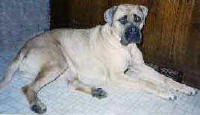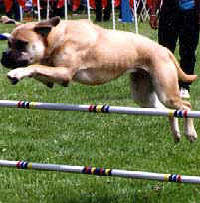 |
||||||||
Dudleyism in the Bullmastiff
It is not possible now to know exactly when the first Dudley type mutation appeared in the Bullmastiff. Possibly the gene was present in the ancestors of some of the original Bullmastiffs. It may have occurred in the early Mastiffs before the English type Bulldog (itself thought to be a dwarf mutation of the early Mastiff) came into being. However, since the Dudley gene seems to occur both in the Bulldog and the Mastiff and there is no real proof, it is pure conjecture which breed endowed the Bullmastiff with Dudleyism. There appear to be two different color forms of Dudleyism in the Bullmastiff. The more common form is the one in which the individual’s body is some shade of mouse gray while the mask and nose are a slightly darker shade of gray. (Website Author’s note: similar to the blue Neopolitan Mastiff) There is another less common form in which the body is a golden fawn color and the mask and nose a cinnamon red. The cinnamon form is quite striking and in its own way even attractive. (Editor’s note: similar to the Dogue de Bordeaux.) Both forms have very light yellow eyes. (Editor’s note: the eyes in the “gray” Dudley begin as baby blue, and turn to yellow as the dog ages.)
The two phases of Dudleyism seem to be inherited separately from each other so it may be possible for one individual to carry both genes. Breeding would be necessary to determine their exact relationship. It is possible that the cinnamon Dudley gene might have been produced in a more recent mutation of the color genes. To understand how Dudleyism is inherited you must first understand that each individual basically has two genes for every characteristic he possesses, each of his parents contributing one gene for each characteristic. The gene for the Dudley color characteristic seems to be inherited as a simple single recessive. This means that an individual may carry the gene and not show any physical evidence that he is a carrier. When one individual carrying the gene is mated to another individual who also carries the gene, then Dudleyism will appear among the puppies. The two genes are combined in every possible combination taking one gene from each parent in each combination. This gives us the ratio of any particular combination to expect in the offspring. It should be understood, however, that these are theoretic ratios and in small samples such as single litter the actual numbers may vary slightly. Just as the theoretic expectancy of getting 50% males and 50% females in each litter may not always hold true, in counting many litters the ratio of males to females will be very close to the theoretic expectations. Those individuals with two genes for normal pigmentation (NN) will have normal coloring and will not carry Dudleyism. 25% of the puppies from the mating of two carriers should fall into this category. Those individuals with one dominant gene for normal color and one recessive gene for Dudleyism (Nn) will be normal in color themselves but will be carriers. 50% of the puppies from the mating of two carriers should fall into this category. Those individuals with two recessive genes for Dudleyism (nn) will exhibit the Dudley color which they have inherited in pure form. 25% of the puppies of two carriers should fall into this category. If two normal, non-carriers are mated they can produce only normal colored, non-carrier offspring. If you are really serious about eliminating Dudleyism completely from your line you will have a rough row to hoe. First you will never again use for breeding an individual who has produced a Dudley. You must suspect the offspring of any known carriers since 50% of them will be carriers. You must also suspect the littermates of any Dudley carrier as 50% of them will be carriers. The only way you can prove that an animal is not a carrier is to deliberately breed to either a Dudley or to a known carrier. If a normal sized litter of at least six to seven puppies results and there are not Dudleys among them you can be fairly sure that the individual you are testing is not a carrier. (Then, however, you are faced with a litter which consists at best of at least 50% Dudley carriers.) Now that you have a proven “clean” individual the trick is to breed it only to other proven “clean” individuals. Then you will have eliminated Dudleyism from your line.
So, if we are going to expend time and effort eliminating faults from our Bullmastiffs, let’s start with the more dangerous faults and concentrate our efforts on some of the physical defects which cause pain and distress to the animal and threaten the future of the breed, such as hip dysplasia, entropian, uterine inertia, hyperplasia and others. This article was written by Joan Davis and appeared in the January, 1970 issue of the Bullmastiff Bulletin, then re-published in the Fall 1996 issue of the Bullmastiff Bulletin by the editor Chris Lezotte. It is being included on this website for educational purposes and all pictures have been graciously contributed to show color examples of what to look for in order to determine what a Dudley Bullmastiff looks like. Other Articles about Dudley Bullmastiffs:
|
||||||||

All
Rights Reserved. Copyright 1994 - 2001 BullmastiffInfo.org
|

 It is my belief that the two color variations of Dudleyism are caused by
two different mutations, one preventing the animal from producing any black pigment at all
(causing the cinnamon phase), and one which causes a faded or diluted appearance (the more
common gray Dudley).
It is my belief that the two color variations of Dudleyism are caused by
two different mutations, one preventing the animal from producing any black pigment at all
(causing the cinnamon phase), and one which causes a faded or diluted appearance (the more
common gray Dudley).
